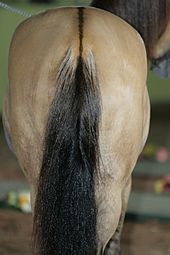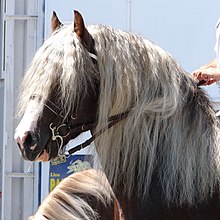Horsehair
It is used for various purposes, including upholstery, brushes, the bows of musical instruments, a hard-wearing fabric called haircloth, and for horsehair plaster, a wallcovering material formerly used in the construction industry and now found only in older buildings.
The texture of horsehair can be influenced by the breed and management of the horse, including natural conditions such as diet or climate.
[1] Horsehair fabrics are woven with wefts of tail hair from live horses and cotton or silk warps.
[6] Another historic use was for gloves commonly used for fishing in the medieval age leading up to the 17th century in cold climates.
[10] It comes primarily from stallions and costs $150–$400 per pound because of the sorting needed to extract long hairs.
The plans, a blueprint for a monastic compound in medieval times, are a national preserved treasure to the Swiss that were said to have been woven with horsehair.
Until the 20th century, it was commonly used to make fine arts paintbrushes, along with sable, fox, wolf, goat, and lamb hair.
In modern times, mane and tail horsehair samples with root tissue attached are commonly used for DNA analysis of equine specimens.


